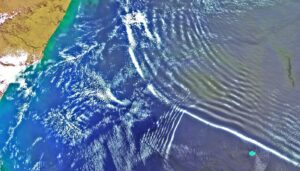
Picture a rock thrown into a lake on a calm day. That is an excellent example of what a gravity wave looks like.
Ripples migrate from where the rock hits the water, causing an up and down motion along the water’s surface. As we get farther away from the point where the rock hit the water, the waves dampen, becoming less defined.
These ripples, or waves, travel along a stable boundary between the water surface and the air above. Gravity waves also occur along stable layers but in the atmosphere.
To understand how gravity waves form, imagine a small volume of air, large enough to contain a very great number of molecules, but small enough so that the properties assigned to it are approximately uniform. In a stable atmosphere, if an air parcel is forced to rise or sink, the parcel will tend to return to its original position. If the air parcel ins in an unstable atmosphere, it will accelerate away from its initial position after being pushed. Atmospheric gravity waves form in stable air when parcels are forced upward and gravity pulls it back down.
As with the stone thrown in a pond, to start a gravity wave in the atmosphere, we need a perturbation to displace an air parcel in the vertical. Flow over mountains and thunderstorm updrafts are good examples of trigger mechanisms. An upward moving parcel expands and cools, making favorable condition for cloud development. A downward moving parcel is compressed and warms, lowering the humidity.
Gravity waves in the atmosphere sometimes appear as rows of clouds between rows of clear area. The upward moving region is the most favorable region for cloud development and the sinking region favorable for clear skies.
Steve Ackerman and Jonathan Martin, professors in the UW-Madison department of atmospheric and oceanic sciences, are guests on WHA radio (970 AM) at 11:45 a.m. the last Monday of each month. Send them your questions at stevea@ssec.wisc.edu or jemarti1@wisc.edu.

